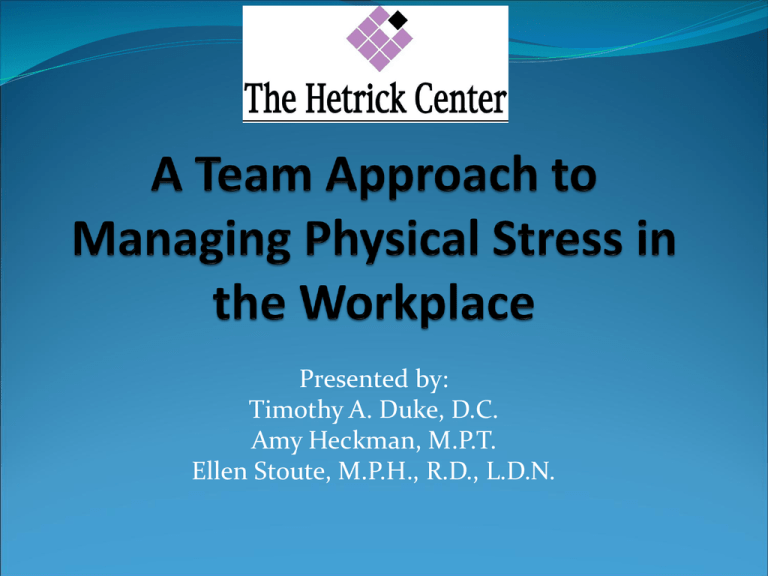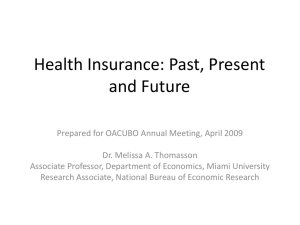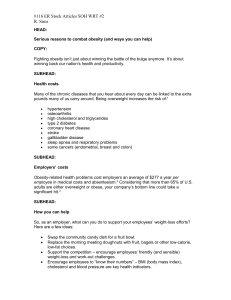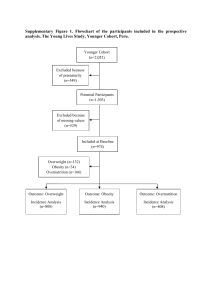A Team Approach to Managing Physical Stress in the
advertisement

Presented by: Timothy A. Duke, D.C. Amy Heckman, M.P.T. Ellen Stoute, M.P.H., R.D., L.D.N. Presentation Outline Timothy A. Duke, D.C. Biomechanics Associated with Common Workplace Injuries, and Anticipated Conservative (Chiropractic) Treatment After They Occur. Amy Heckman, M.P.T. Appropriate Stretching and Strengthening to Prevent Injuries in the Workplace. Ellen Stoute, M.P.H., R.D., L.D.N. Obesity Trends and Worksite Wellness to Maintain Optimal Health and Minimize Workplace Stress and Injury. Presented By: Timothy A. Duke, D.C. Learning Objectives Discuss common workplace injuries Strain/sprain Discuss the biomechanics of common workplace conditions Lifting Sitting Expected conservative treatment associated with common occupational injuries Active vs. Passive Common Workplace Injuries Strain/Sprain (S/S) Most common (40%) Special consideration Other Injuries Musculoskeletal disorders (29%) “Ergonomic Injuries” Cuts/lacerations (8%) Fractures (7%) * All stats provided by www.OSHA.gov Strain/Sprain (S/S): A Special Consideration Why a special consideration? Preventable How/why do these occur? Acute vs. repetitive Overexertion Improper lifting Slip and fall Etc… Grading a Strain/Sprain All S/S are not created equal Literature accepts three grades Grade I Grade II Grade III Injury grade and timing are going to lay out the frequency, duration, and appropriate type of treatment Passive to Active Lifting Biomechanics Why discuss lifting biomechanics? Education Why does improper lifting cause so much injury? SPINE study 2006 Measured the change in load to the lumbar spine with external weight, as flexion occurs At 30 degrees the force was approx. four times greater Takahashi et al. Mechanical Load of the Lumbar Spine During Forward Bending Motion of the Trunk-A Biomechanical Study. SPINE vol 31, number 1, pp 18-23 2006. Lifting Biomechanics Journal of Occupational Rehabilitation Low back loads vs. positions resulting in low back pain Previous studies have looked at body position in regards to causation of LBP, resulting in mixed results. Looked at cumulative low back loads and their relation to LBP Results up to 49% experienced pain in at least one of the followup years (3 years of follow-up performed) Coenen et al. Cumulative Low Back Load at Work as a Risk Factor of Low Back Pain: A Prospective Cohort Study. Journal of Occupational Rehabilitation. Online 21 June 2012. Lifting Biomechanics SPINE Study 2000 Compared both cumulative lifting AND trunk position while lifting Correlated time spent in a flexed position, rotated position, and also compared various load weights and frequency of lifting. Results: Increased risk of LBP were noted with workers working in a 60° flexed position at least 5% of the day, working in a 30° rotated position 10% of the day, and lifting a load of 25kg more than 15 times/day. Hoogendoom et al. Flexion and Rotation of the Trunk and Lifting at Work Are Risk Factors for Low Back. SPINE. Vol 25, number 23, pp 3087-3092, 2000. Postural Biomechanics Why be concerned by postural biomechanics? Second leading cause of occupational injury (“ergonomic injury”) Very preventable Weight considerations What is considered “good” postural biomechanics/ergonomics? “Good” Ergonomic Position Manual Therapy Journal Studies 2005 Study Compared various muscle activities in “postural” muscle groups through EMG (electromyography), in people performing monotonous keyboard work. Even with proper ergonomics the studies subjects noted not only pain, but increased muscle activity Szeto et al. A comparison of symptomatic and asymptomatic office workers performing monotonous keyboard work-1: Neck and shoulder muscle recruitment patterns . Manual Therapy 10 (2005) pp 270-280. 2009 Study Compared muscle activity levels through EMG in resting positions vs. task specific positions. Muscle activity increased approximately three times with task specific positions as compared to resting positions Szeto et al. Neck-shoulder muscle activity in general and task-specific resting postures of symptomatic computer users with chronic neck pain. Manual Therapy 14 (2005) pp 338-345. Conservative Treatment Options What is considered a good trial of Chiropractic care? Mercy Guidelines How should improvement be measured? If a person is not responding what should be done next? Chronic care considerations Passive vs. Active Treatment Passive Treatment What is considered passive treatment? Manipulation Modalities Active Treatment What is considered active treatment? Rehabilitation Soft Tissue Healing: What to Expect? Phases of soft tissue healing Acute Remodeling Repair Timing plays a key role in the appropriate treatment of softtissue injuries Aggressive treatment early on can lead to chronic ongoing problems Too much passive treatment later on can lead to a lack of progress. Presented by: Amy Heckman, M.P.T. Learning Objectives Importance of core muscles Importance of stretching Common core and stretching exercises Importance of Core Strength What is your “core”? Girdle of muscles that surround the midsection of your body What is the purpose of your core muscles? Support posture (static and dynamic) Create motion Coordinate muscle actions Keep up stable How does the core help reduce injury? Helps limit stress of movement Helps prevent laxity of joints of your spine Excess movement of the bones in your spine due to weak core can result in damage to the joints Basic Core Exercises Diaphragmatic Breathing Start lying on your back with feet shoulder width apart and your hands on your lower abdomen (Be aware of the position of your back on the floor) Take a breath in through your nose for a count of 4 and feel how your back gently arches off the floor Slowly blow out through pursed lips like you are blowing a balloon for 8 seconds and think of "releasing" your back and notice how it moves closer to the floor After each cycle rest and breathe normally, but notice how your back feels. Do this before and after your other exercises. To start you may have to do shorter breathe cycles until your diaphragm is trained Basic Core Exercises Posterior Pelvic Tilt Lie on your back on a firm surface with knees comfortably bent (top picture) Then flatten back against the table while contracting abdominal muscles as if pulling belly button toward ribs (bottom picture) Basic Core Exercises Plank Start face down with elbows on a mat directly below your shoulder and pull your core up, creating a plank position on your toes and elbows. Hold until you feel a shake then hold for ten more seconds Side Plank on Knees Put your weight on the bottom knee and elbow. Keep neck straight and abdominals in. Hold position until you feel your body shaking then hold for ten more seconds Basic Core Exercises Curl-Up (Reverse) While lying on your back with your knees bent, raise up your legs and lift your buttocks Maintain the same leg position the entire time Benefits of Stretching Decrease Muscle Strain/Sprain Decrease Tendonitis/Tendonosis conditions Allow Joints to move properly through their range of motion How to Stretch Effectively Do not stretch a cold muscle Warm up 5 to 10 min. prior to stretching (or stretch after activity) Do not bounce Bouncing can cause small micro tears in muscle Tears produce scar tissue in muscle Scar tissue leads to less flexibility How to Stretch Effectively Hold each stretch about 30 seconds Repeat each stretch 3 to 4 times Stretch until you feel tension, not pain Stretch on a regular basis Static verse Dynamic Stretching Static stretches effect the collagen fibers of your muscles Static stretches help reduce injury by maximizing flexibility and improving biomechanics Static stretches help increase and maintain a muscle length and flexibility Static verse Dynamic Stretching Dynamic stretching effect the golgi tendon organs of a muscle The golgi tendon organs measure muscle tension to protect it from injury The structures can over react if not properly prepared for activity The golgi tendon organs can stimulate a protective/reflexive muscle contraction at a time of rapid acceleration Dynamic stretches can decrease the reactiveness of the golgi tendon organs and limit number of muscle strains experienced during quick acceleration activities common in sports Important Day-To-Day Stretches Neck Stretches Upper Trapezius - Tilt your head towards the side, then return back to looking straight ahead. (Be sure to keep you eyes and nose pointed straight ahead the entire time) Levator Scapulae - Turn your head towards the side, then return back to looking straight ahead Cervical Retraction - Slowly draw your head back so that your ears line up with your shoulders Important Day-To-Day Stretches Pectoralis Major/Minor Stretch While standing at a corner of a wall, place your arms on the walls with elbows bent so that your upper arms are horizontal and your forearms are directed upwards as shown Take one step forward towards the corner and bend your front knee until a stretch is felt along the front of your chest and/or shoulders Your arms should be pointed downward towards the ground. NOTE: Your legs should control the stretch by bending or straightening your front knee Important Day-To-Day Stretches Wrist Flexor Stretch Use your unaffected hand to bend the affected wrist down as shown Keep the elbow straight on the affected side the entire time Wrist Extensor Stretch Use your unaffected hand to bend the affected wrist up as shown Keep the elbow straight on the affected side the entire time Important Day-To-Day Stretches Standing Quad Stretch While in a standing position, bend your knee back behind and hold your ankle/foot Next, gently pull your knee into a more bent position Important Day-To-Day Stretches Hamstring Stretch While lying down on your back, hook a towel or strap under your foot and draw up your leg until a stretch is felt under your leg calf area Keep your knee in a straightened position during the stretch Can also be done in standing Keep knee in straightened position and flex forward at hips Remember to keep your back straight Important Day-To-Day Stretches Gluteal Stretch While Lying on your back, hold your knees and gently pull them up towards your chest Important Day-To-Day Stretches Piriformis Stretch While lying on your back with both knee bent, cross your affected leg on the other knee Next, hold your unaffected thigh and pull it up towards your chest until a stretch is felt in the buttock Important Day-To-Day Stretches Standing Calf Stretch (Gastroc.) While standing and leaning against a wall, place one foot back behind you and bend the front knee until a gentle stretch is felt on the back of the lower leg Your back knee should be straight the entire time References 1. "Strength and Conditioning Journal"; Core Stability Training for Healthy Athletes: A Different Paradigm for Fitness Professionals; Jeffery Willardson, Ph.D., CSCS; December 2007 2. "NSCA's Performance Training Journal"; Connecting the Core; Paul Goodman, MS, CSCS; November 2004 3. "NSCA's Performance Training Journal'; Core Training for Improved Performance; Tracy Handzel, CSCS; December 2008 4. Core Muscle Training: Keep Your Abdominal Muscles Strong to Prevent Injuries | Suite101.com http://suite101.com/article/core-muscle-traininga50442#ixzz26PX3C96W 5. “To stretch or not to stretch: The role of stretching in injury prevention and performance.” Scandinavian Journal of Medicine and Science in Sports. 2010 6. ACSM's Primary Care Sports Medicine. 2nd ed. Philadelphia, Pa 7. Dynamic stretching warm-up intervention elicits longer-term performance benefits. Journal of Strength and Conditioning Research. 2008;4:1286.0.Rancour J, et al. Presented by: Ellen Stoute, M.P.H, R.D., L.D.N. Learning Objectives Calculate and interpret Body Mass Index Identify Health Risks Associated with Obesity Recognize the Benefits of a Worksite Wellness Program Strategies to Implement a Health Promotion Initiative Definition of Overweight and Obesity Body mass index (BMI) Math formula used to assess overweight and obesity Multiply weight in pounds by 703 Then divide result by height in inches Then divide that result by height in inches again BMI Table Underweight Normal Overweight Obese I Obese II Obese III BMI < 18.5 18.5 - 24.9 25.0 - 29.9 30.0 - 34.9 35.0 - 39.9 ≥ 40 Limited because it doesn’t measure body fat or muscle directly Health Risks Obesity is more than a cosmetic problem Overweight and obesity are risk factors for Type 2 diabetes Coronary heart disease High blood cholesterol Stroke Hypertension Gallbladder disease Osteoarthritis (degeneration of cartilage and bone of joints) Sleep apnea and other breathing problems Some forms of cancer (breast, colorectal, endometrial, kidney) Fatty liver disease Gastroesophageal reflux Gout Reproductive problems in women Obesity is Also Associated With… Complications of pregnancy Menstrual irregularities Hirsutism (presence of excess body and facial hair) Stress incontinence (urine leakage caused by weak pelvic floor muscles) Psychological disorders, such as depression Increased surgical risk Increased mortality Type II Diabetes High blood sugar levels Major cause of heart disease, kidney disease, stroke, amputation, blindness 6th leading cause of death in U.S. > 85% of people with Type 2 diabetes are overweight Losing 5-10% of your body weight and doing moderateintensity exercise for 30 minutes, 5 days a week, may prevent or delay onset of Type 2 diabetes Coronary Artery Disease Arteries become hardened and narrowed Can cause heart attack Coronary heart disease is the leading cause of death in U.S. People who are overweight are more likely to develop risk factors for heart disease like high blood pressure and cholesterol Losing 5-10% of your weight can lower your chances for developing coronary heart disease Cancer 2nd leading cause of death in U.S. Being overweight may increase risk of developing several types of cancer, including cancers of the colon, esophagus, kidney, uterine, breast It is not known exactly how being overweight increases cancer risk Sleep Apnea Stop breathing for short periods during the night Can cause daytime sleepiness, difficulty concentrating, heart failure Risk for sleep apnea higher for overweight people More fat stored around neck may make airway smaller, which makes breathing difficult Weight loss usually improves sleep apnea Osteoarthritis Extra weight places extra pressure on joints and cartilage, causing them to wear away Weight loss of 5% of your body weight may decrease stress on your knees, hips, and lower back Psychological and Social Effects Emotional suffering may be one of the most painful parts of obesity Obese often face prejudice or discrimination in job market, at school, and in social situations Feelings of rejection, shame, or depression may occur BMI and the Workplace There is a relationship between higher BMI and workplace injuries, short-term disability, compensation claims and lost man-hours. In 2008, 335,390 cases were reported when someone had to take days off from work due to an ergonomic injury. Average length of absence = 9 days Study Results April 2007 study revealed Worker’s Compensation claims filed by employees with a BMI over 40 were more than double of those by healthy-weight employees. Lost work days for obese group were 12 times as high as the healthy-weight group. Medical costs were almost 7 times higher American Journal of Epidemiology 85% of all injured employees in a manufacturing plant were classified as overweight or obese. The odds of injury for employees in the obese group were more than double that of healthy-weight employees. Injuries Most common injury in the workplace suffered by employees with high BMI’s occurred in the leg or knee. Other frequent injuries were in the wrist, hand and back. Common complaints were inflammation, pain, contusions, strains and sprains. One study found patients with a BMI over 29 were 2.5 times more likely to be diagnosed with carpal tunnel syndrome than patients with a healthy BMI Obesity Trends Dramatic increase in obesity in U.S. over past 20 years More than 64% of U.S. adults are either overweight or obese Obesity Trends* Among U.S. Adults BRFSS, 1985 (*BMI ≥30, or ~ 30 lbs. overweight for 5’ 4” person) No Data <10% 10%–14% Obesity Trends* Among U.S. Adults BRFSS, 1986 (*BMI ≥30, or ~ 30 lbs. overweight for 5’ 4” person) No Data <10% 10%–14% Obesity Trends* Among U.S. Adults BRFSS, 1987 (*BMI ≥30, or ~ 30 lbs. overweight for 5’ 4” person) No Data <10% 10%–14% Obesity Trends* Among U.S. Adults BRFSS, 1988 (*BMI ≥30, or ~ 30 lbs. overweight for 5’ 4” person) No Data <10% 10%–14% Obesity Trends* Among U.S. Adults BRFSS, 1989 (*BMI ≥30, or ~ 30 lbs. overweight for 5’ 4” person) No Data <10% 10%–14% Obesity Trends* Among U.S. Adults BRFSS, 1990 (*BMI ≥30, or ~ 30 lbs. overweight for 5’ 4” person) No Data <10% 10%–14% Obesity Trends* Among U.S. Adults BRFSS, 1991 (*BMI ≥30, or ~ 30 lbs. overweight for 5’ 4” person) No Data <10% 10%–14% 15%–19% Obesity Trends* Among U.S. Adults BRFSS, 1992 (*BMI ≥30, or ~ 30 lbs. overweight for 5’ 4” person) No Data <10% 10%–14% 15%–19% Obesity Trends* Among U.S. Adults BRFSS, 1993 (*BMI ≥30, or ~ 30 lbs. overweight for 5’ 4” person) No Data <10% 10%–14% 15%–19% Obesity Trends* Among U.S. Adults BRFSS, 1994 (*BMI ≥30, or ~ 30 lbs. overweight for 5’ 4” person) No Data <10% 10%–14% 15%–19% Obesity Trends* Among U.S. Adults BRFSS, 1995 (*BMI ≥30, or ~ 30 lbs. overweight for 5’ 4” person) No Data <10% 10%–14% 15%–19% Obesity Trends* Among U.S. Adults BRFSS, 1996 (*BMI ≥30, or ~ 30 lbs. overweight for 5’ 4” person) No Data <10% 10%–14% 15%–19% Obesity Trends* Among U.S. Adults BRFSS, 1997 (*BMI ≥30, or ~ 30 lbs. overweight for 5’ 4” person) No Data <10% 10%–14% 15%–19% ≥20% Obesity Trends* Among U.S. Adults BRFSS, 1998 (*BMI ≥30, or ~ 30 lbs. overweight for 5’ 4” person) No Data <10% 10%–14% 15%–19% ≥20% Obesity Trends* Among U.S. Adults BRFSS, 1999 (*BMI ≥30, or ~ 30 lbs. overweight for 5’ 4” person) No Data <10% 10%–14% 15%–19% ≥20% Obesity Trends* Among U.S. Adults BRFSS, 2000 (*BMI ≥30, or ~ 30 lbs. overweight for 5’ 4” person) No Data <10% 10%–14% 15%–19% ≥20% Obesity Trends* Among U.S. Adults BRFSS, 2001 (*BMI ≥30, or ~ 30 lbs. overweight for 5’ 4” person) No Data <10% 10%–14% 15%–19% 20%–24% ≥25% Obesity Trends* Among U.S. Adults BRFSS, 2002 (*BMI ≥30, or ~ 30 lbs. overweight for 5’ 4” person) No Data <10% 10%–14% 15%–19% 20%–24% ≥25% Obesity Trends* Among U.S. Adults BRFSS, 2003 (*BMI ≥30, or ~ 30 lbs. overweight for 5’ 4” person) No Data <10% 10%–14% 15%–19% 20%–24% ≥25% Obesity Trends* Among U.S. Adults BRFSS, 2004 (*BMI ≥30, or ~ 30 lbs. overweight for 5’ 4” person) No Data <10% 10%–14% 15%–19% 20%–24% ≥25% Obesity Trends* Among U.S. Adults BRFSS, 2005 (*BMI ≥30, or ~ 30 lbs. overweight for 5’ 4” person) No Data <10% 10%–14% 15%–19% 20%–24% 25%–29% ≥30% Obesity Trends* Among U.S. Adults BRFSS, 2006 (*BMI ≥30, or ~ 30 lbs. overweight for 5’ 4” person) No Data <10% 10%–14% 15%–19% 20%–24% 25%–29% ≥30% Obesity Trends* Among U.S. Adults BRFSS, 2007 (*BMI ≥30, or ~ 30 lbs. overweight for 5’ 4” person) No Data <10% 10%–14% 15%–19% 20%–24% 25%–29% ≥30% Obesity Trends* Among U.S. Adults BRFSS, 2008 (*BMI ≥30, or ~ 30 lbs. overweight for 5’ 4” person) No Data <10% 10%–14% 15%–19% 20%–24% 25%–29% ≥30% Obesity Trends* Among U.S. Adults BRFSS, 2009 (*BMI ≥30, or ~ 30 lbs. overweight for 5’ 4” person) No Data <10% 10%–14% 15%–19% 20%–24% 25%–29% ≥30% What Causes Obesity? Energy Imbalance The same amount of energy IN and energy OUT over time = weight stays the same More IN than OUT over time = weight gain More OUT than IN over time = weight loss Overweight and obesity happen over time when you take in more calories than you use What Causes Obesity? Physical Inactivity Less than 1/3 of adults do the recommended amount of physical activity (at least 30 minutes most days) Americans aren’t physically active for many reasons Spending hours in front of TVs and computers doing work, schoolwork, and leisure activities > 2 hours a day of regular TV viewing time has been linked to overweight and obesity Relying on cars instead of walking to places Fewer physical demands at work or at home because modern technology and conveniences reduce need to burn calories Lack of physical education classes in schools What Causes Obesity? Environment Lack of neighborhood sidewalks and safe places for recreation Long hours at work and time spent commuting Oversized food portions Lack of access to healthy foods Neighborhoods without supermarkets Healthy foods often cost more Food advertising What Causes Obesity? Genes and Family History Genes have strong influence on weight Your chances of being overweight are greater if your parents are overweight Children adopt the habits of their parents What Causes Obesity? Lack of Sleep People who sleep 5 hours a night are much more likely to become obese compared to people who sleep 7–8 hours People who sleep fewer hours seem to prefer eating foods that are higher in calories and carbohydrates Hormones released during sleep control appetite and body’s use of energy Weight Loss Goals Lose 5-10% of your current weight over 6 months Will lower your risk for heart disease and other conditions Best way to lose weight is slowly 1-2 lbs a week is doable, safe, and will help you keep off the weight Measuring Success Look at many factors to gauge success with weight loss efforts Number on scale How clothes fit Blood pressure Cholesterol HbA1C Fitness level Etc. Worksite Wellness 81% of America’s businesses with 50 or more employees have some form of health promotion program. Medical costs can consume half of corporate profits or more Worksite wellness is an investment in your most important asset—your employees. Top 5 Reasons for Worksite Wellness #1--Health Care Costs We spend over $1 trillion dollars on healthcare Average annual cost per person exceeds $3,000 41 million Americans are without healthcare insurance Most of these costs are linked to health habits Reason #2 - Most Injuries Can Be Avoided Preventable illnesses make up approximately 70% of the entire burden of illness associated costs in the US. Preventable factors include: Tobacco use High-risk alcohol consumption Sedentary lifestyles Poor nutritional habits Reason #3 – The Work Week is Expanding Typical American works 47 hours a week - 164 more hours than only 20 years ago If trend continues average person will be on the job 60 hours a week Technology has erased traditional work boundaries Reason #4 – Technology Revolution Reliance on technology has caused new health concerns including: repetitive stress injuries, low back problems, and compromised vision One-third of the workforce spends their day seated at their desks plugged into workstations Sedentary lifestyles major concern Reason #5 – Employee Stress Levels Are Rising Information explosion—more information has been produced in the last 30 years than during the previous 5,000 78% of Americans describe their jobs as stressful Vast majority indicated their stress levels have worsened over the past 10 years Benefits of Workplace Wellness Programs Healthier Employees Fewer Injuries Improved Productivity Lower Absenteeism Reduced Medical Costs Increased Job Satisfaction Decreased Employee Turnover Journal of Occupational and Environmental Medicine Study published in 2008 focused on a company with an employee wellness program. Researchers evaluated health care costs during a 4 year period to establish cost-effectiveness. Study found the company had saved over $1.3 million as a result of lower health care costs incurred by program participants. Where Do We Begin? Establish a Wellness Committee Employee involvement is vital Assess Employee Needs and Interests Employee interest survey Conduct a Worksite Organizational Health Survey. Physical Activity Does your worksite have a place for employees to go for a walk? Does your organization have organized physical activities for employees? Access to physical activity facilities for employees? Access to an indoor exercise facility? Physical Activity Subsidize memberships to off-site physical activity facilities? Are there stairs employees can use for physical activity? Incentives or rewards to employees who are physically active? Do you offer a health plan which provides discounts for health club membership? Nutrition Can employees obtain food or snacks at the workplace? Where are the food or snacks offered? What types of foods are available through vending machines? Does your organization have written policies or guidelines to ensure that fruit, vegetables and salads are offered at catered meetings? Nutrition Do you have a place where employees can refrigerate and heat meals? Do you offer nutrition education programs to your employees? Does your organization offer weight control programs? Reimbursement or discounts for dietary counseling? Smoking Does your organization have a written smoke-free environment policy? Are employees who violate the policy penalized in any way? Do you offer programs to help employees quit smoking? Do you offer reimbursement or discounts to employees who enroll in programs to quit smoking? Other Health Programs Health education classes, workshops, lectures, or special events Health screening services Are employees allowed to use paid work time to participate in health related activities? Solicit feedback from employees on health programs that would be beneficial to them In Summary Most popular worksite wellness programs are Exercise Smoking Cessation Classes Back Care Programs Stress Management There are numerous compelling reasons why every organization should consider developing a worksite health promotion initiative.








